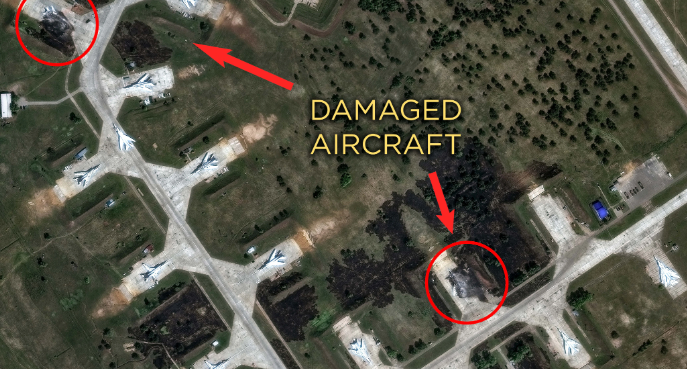
Satellite Imagery Shows Damage to Two Russian Air Bases After Ukrainian Drone Strikes
Under Operation Spider Web, Ukraine launched a drone attack against the Belaya Air Base in Irkutsk, Siberia; the Olenya Air Base in Murmansk, the Arctic area; the Ivanovo Severny Air Base in Ivanovo; the Dyagilevo Air Base in Ryazan; and the Ukrainka Air Base in Russia’s Far East.
A glimpse of the devastation wreaked by the explosive-laden drones has been provided by high-resolution satellite photographs of two of the five Russian air stations that Ukraine targeted in its bold drone operation. Due to cloud cover over these air bases, which are all located deep within Russian territory, clear photographs have not been captured until more than 48 hours after the attack.
The Belaya Air Base in Irkutsk, Siberia; the Olenya Air Base in Murmansk, the Arctic; the Ivanovo Severny Air Base in Ivanovo; the Dyagilevo Air Base in Ryazan; and the Ukrainka Air Base in Russia’s Far East were all targeted by Ukraine as part of Operation Spider Web. The closest of these air bases is almost 500 kilometres away from the Ukrainian border, while the furthest one is up to 8,000 km away.
The damage to Russian air infrastructure is evident in the most recent satellite photos taken after the strike of the Belaya and Olenya air bases. The wreckage of multiple military aircraft that were parked on the tarmac at the time of the attack is visible at both of these airbases.
The fuselage and wings of at least two of Russia’s leading bombers, the Tupolev Tu-95, were reduced to ashes in satellite images obtained on June 4 at the Belaya air base, which is more than 4,000 miles within Russian territory. The explosions here were so powerful that debris was thrown almost a hundred meters distant, where a painted decoy on the tarmac could be seen.
Four Tupolev Tu-22 supersonic bombers, a mainstay of the Russian Air Force, are seen parked on the tarmac in another image, while a fifth is seen farther down the parking bay, entirely destroyed. Parts of the destroyed aircraft appear to have been taken from the location in the last two days, indicating some cleanup action.
Although the Tupolev Tu-22 is used to target enemy aircraft carriers and other enemy naval assets, these svelte bombers have also been utilised for missions that target ground-based military facilities located deep within enemy territory because of their speed, agility, and versatility.
Completely destroyed were a number of other planes, all bombers, positioned in a zigzag pattern at the Belaya airport. Although it is certain that the Ukrainian attack destroyed at least ten bombers at the Belaya airbase, it is hard to estimate how many of each type of bomber aircraft were lost because of the Russian Air Force’s cleanup efforts over the last 48 hours.
Satellite images at the Olenya Airbase, which is 2,000 kilometres from Ukraine’s border in the Arctic, show several planes standing next to one another on the tarmac, which is now covered in ash and dust.
Tough pre-attack satellite photographs show that the Tu-22 and Tu-95 aircraft were also stationed here, making it difficult to determine which of Russia’s military jets were killed. The first footage of the Ukranian drone strike, which showed explosive-laden drones primarily targeting Tu-95 bombers, came from this air base. These bombers were parked side by side on the tarmac, and the video shows smoke rising from them.
The three other air bases that Ukraine attacked are still heavily clouded, and high-resolution satellite photos are probably not going to be available until the weather clears. According to Ukraine, up to 41 Russian military jets have been destroyed in the Trojan-horse-style operation, in which drones were smuggled covertly inside container trucks and then remotely deployed, even though satellite images taken today show at least ten aircraft being targeted.
The fact that these air bases are situated so far within Russia that the sheer distance was sufficient to protect planes from a Ukrainian strike is likely what took Moscow off guard. Although Ukraine has also received missiles from its Western partners, the US-made ATACMS and the British-French-made Storm Shadow, neither of which has the range to strike these air sites deep within Russian territory.
The Russian Air Force, which has a far larger fleet of aircraft, continues to have air superiority over Ukraine despite the successful drone attack. However, the offensive by Ukraine has significantly improved Kyiv’s morale while severely harming Moscow’s.
Vladimir Putin has promised to react to Ukraine’s attack, according to US President Donald Trump, who spoke with Putin for more than an hour today. “I just finished speaking, by telephone, with President Vladimir Putin, of Russia,” President Trump wrote in a post on the social networking site Truth Social. The duration of the call was almost one hour and fifteen minutes. We talked about Ukraine’s attack on Russia’s moored aircraft as well as other attacks that both parties have been carrying out. Although the conversation was fruitful, it won’t result in instant peace. He will have to retaliate to the recent attack on the airfields, President Putin stated emphatically.


